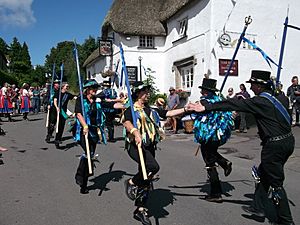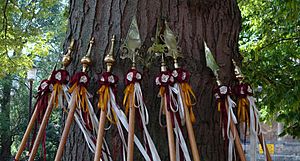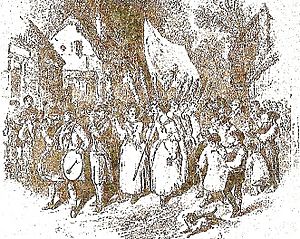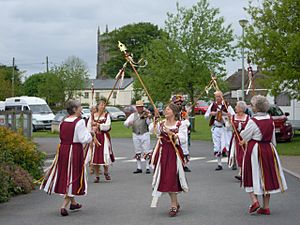Stave dancing facts for kids
Stave dancing is a special type of folk dance from the southwest of England. You can find it in places like Somerset, Dorset, and Wiltshire. Dancers carry long, decorated poles called staves over their shoulders. They perform different moves while holding these poles.
This dance style almost disappeared in the 1920s. But in the 1980s, people became interested in it again. Now, many Morris and country dancing teams keep this tradition alive. Some people believe stave dancing started from the yearly 'club-walks' of friendly societies.
Contents
How Stave Dancing Works
Stave dances are a bit like English country dances. The main difference is that dancers carry a stave over their right shoulder. Dancers are in mixed groups, often sets of four, six, or eight people. They perform different patterns and moves. Traditional country dance tunes play along with them.
The steps are similar to those in some Morris and country dances. These include double-stepping, a traveling 'ranting' or 'polka' step, and a 'chasing' step. This chasing step is also known as a 'Dorset skip-change' step. Most of the time, dancers keep the staves on their shoulders. But in some dances, they use the staves to form arches or other shapes.
We don't know many of the original dances. Most dances performed today come from a few villages in Somerset and Dorset. These include Stourton Caundle and Fifehead Magdalen. However, many new dances have been created in this style.
What Dancers Wear and Use
It's thought that dancing staves came from the poles used by friendly society leaders. These leaders carried their staves on special occasions. These poles were similar to the official staves carried by town leaders for hundreds of years.
Today's dancing staves are wooden poles. They are usually four to six feet long. Each stave has an emblem on top, made of wood or brass. Ribbons often decorate the staves. Blue was a common color for friendly societies.
Each friendly society had its own dress code. Generally, members had to be "decently dressed" for club walks. This usually meant wearing their best clothes. Leaders often wore black coats, sometimes tailcoats. A blue sash was also common for leaders. Some societies required white trousers for leaders. Hats were also needed, usually top hats for leaders. Members might wear bowler hats or caps. Hats were often decorated with blue ribbons or a blue flower-like decoration. Modern stave dancing teams sometimes copy these old styles of dress and equipment.
Where Stave Dancing Began
The English Folk Dance and Song Society suggests that stave dancing started with friendly societies. This happened in the southwest of England in the mid-1800s. Friendly societies helped their members by providing money if they were sick or died. They also had fun social events to bring members together.
One of these events was the yearly 'club walk'. This was a social day that usually included a parade, a church service, and a dinner. There was also music and other entertainment. During these events, members and leaders carried staves. These staves showed their official role.
It is believed that at some club walks, people started dancing while carrying their staves. This led to the development of stave dancing. We don't have many old records about this. However, a letter from around 1880 describes stave dancing in Shrawley, Worcestershire:
My grandfather died two years ago and with him went a great deal of knowledge of what used to happen in Shrawley on Whit-Monday and Midsummer's Day. I do not know when the dancing, the mummers or the "Club Walk" died out. He took part in all these until he joined the army as a lad of 17 which would be around 1878-1880 (for he was 94 when he died). The dancing seems to have been processional in character, headed by the local dignitaries, starting and finishing at the "Rose & Crown" and perambulating the bounds of the parish. They carried long poles topped by "crowns" (he called them) which seem to have been bunches of flowers. The poles were painted "like a barber's pole". The walk took place at Whit & Midsummer.
—D.Taylor, Helm Collection
Other old records, like newspaper reports, suggest the tradition ended by the late 1920s. The last known dance was in Shepton Beauchamp in 1928.
Bringing Stave Dancing Back
The return of stave dancing is mostly thanks to one person, Roy Dommett. He was a scientist and a well-known folk dance expert. Dommett found many mentions of stave dancing while researching English folk dance in the 1970s. Some of his information came from Maud Karpeles.
After looking at all the old records he could find, Dommett believed stave dancing was a unique English folk dance style. He thought it deserved to be recognized alongside other dance traditions. There wasn't much information on the exact dance steps or music. So, with the help of Morris dancing teams like Bath City Morris, Dommett created new versions of the dances:
During a search for mentions of details of rural ceremonial costumes, I found in Friendly Society records some information about the dances done at some of the places that danced as part of their annual perambulation before their Club Day church service and feast. Club Walks are also mentioned in Barnes' poems and in books, and some details have appeared in print. At Stourton Caundle the material is a list of first and second parts which translated well into figures and choruses; at Fifehead Magdalen a list of titles of dance[s] to be practiced, some of which could be traced to printed source books; and a brief description [in] a newspaper account of a dance at a wedding at Buckhorn Weston; and finally odd dances described in manuscripts such as Maud Karpeles [from] Seend in Wiltshire. The material has been given to southern sides who wanted to dance something local.
Many Societies ended the day with a dance and some included dancing in the activities during the Club Walk. Raymond in ‘Country Life’ 1934, mentions the dancing of Hunt the Squirrel and the Four Hand Reels. Maud Karpeles collected a finishing dance in Wiltshire which was a version of Up the Sides and Down the Middle. At Paulton near Bath, stepdancing is specifically mentioned in a local history. Where formal dancing was done it was derived directly from contemporary social dance. Dancing seems to have featured west of Gillingham, Dorset where a newspaper account described dancing at a wedding at Buckhorn Weston, the men carrying their staves to do a version of the Six Hand Reel. The minute book of Fifehead Magdalen in north Dorset states that Haste to the Wedding, Pop Goes the Weasel, the Dorsetshire March and Spithead Fleet would be practiced and danced at the stations on the walk. At Stourton Caundle, near Sturminster Newton in Dorset, a note exists of a set of three dances.
For many years, Roy Dommett worked hard to make stave dancing a recognized folk dance style. He encouraged people to perform it through workshops and talks. Today, many teams perform variations of Dommett's dances. They also create new dances in this style. A small number of Morris dancing teams across southwest England perform them. These include Somerset Morris, Fleur-de-Lys Morris, and Bradninch Millers.






